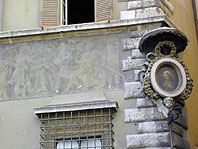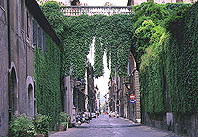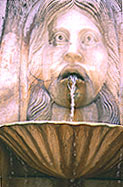Via Giulia
Palazzo Ricci
 (Front facade 1634).
(Front facade 1634).
At the rear facade of this lugubrious building, don't miss the Renaissance "grisaille" frescoes executed in mid-16C by the minor Renaissance artist Polidoro da Caravaggio.
St. Eligio
Raphael was the first architect of this little jewel (1516) located down a side street, which is the church of the Gold and Silversmiths (Eligio was a goldsmith).
St. Caterina da Siena
(1526, architect Baldassare Peruzzi). Like the churches of the Florentines and the Neapolitans on upper Via Giulia, this is Sienna's community church in Rome, as indicated by the crest on the sober Renaissance facade.
Palazzo Falconieri
In 1638 Orazi Falconieri of Florence commissioned Borromini to unite two buildings he had acquired from the Odescalchi and Farnese families.
The result is impressive if somewhat austere. The master's touch is visible in the lovely sun-drenched loggia overlooking the river at the rear, and in the falcon heads on elongated female busts overlooking the street.
St. Maria dell'Orazione e Morte
Yet another confraternity, this one (1576, rebuilt 1737 by Ferdinando Fuga) devoted to picking up the bodies of the unclaimed dead and giving them a decent burial.
There used to be spacious storage halls for the corpses and several openings over the river at the rear.
Here they hauled in the bodies that were found each morning floating in the Tiber, showing why the Tiber has always been polluted. Winged skulls are the macabre motif on the doorways along with the reminder "me today, thee tomorrow!".
Arch of Palazzo Farnese

(Arco di Palazzo Farnese) (1603).
Designed by Michelangelo as part of a bridge that was supposed to continue across the Tiber so that the Farnese family could use a private aerial street to go from its Palazzo Farnese on this bank to its Villa Farnesina property across the river without having to mix with the "hoi poloi".
Fontana del Mascherone

(Fountain of the Giant Mask).
A grotesque face drooling water into a giant's bathtub: two marble objects left over from ancient Rome.
For centuries this Baroque fountain spurted wine during festivals.